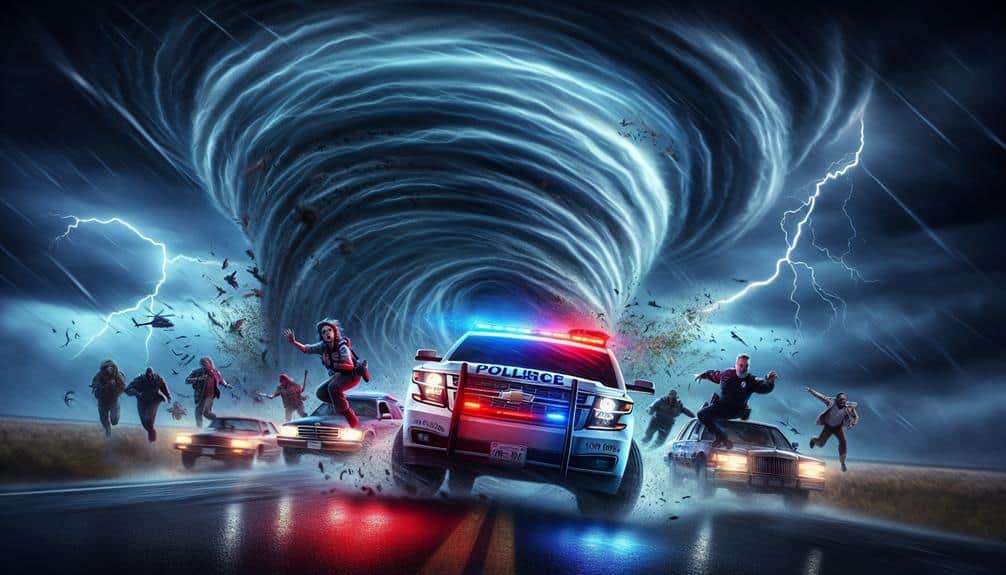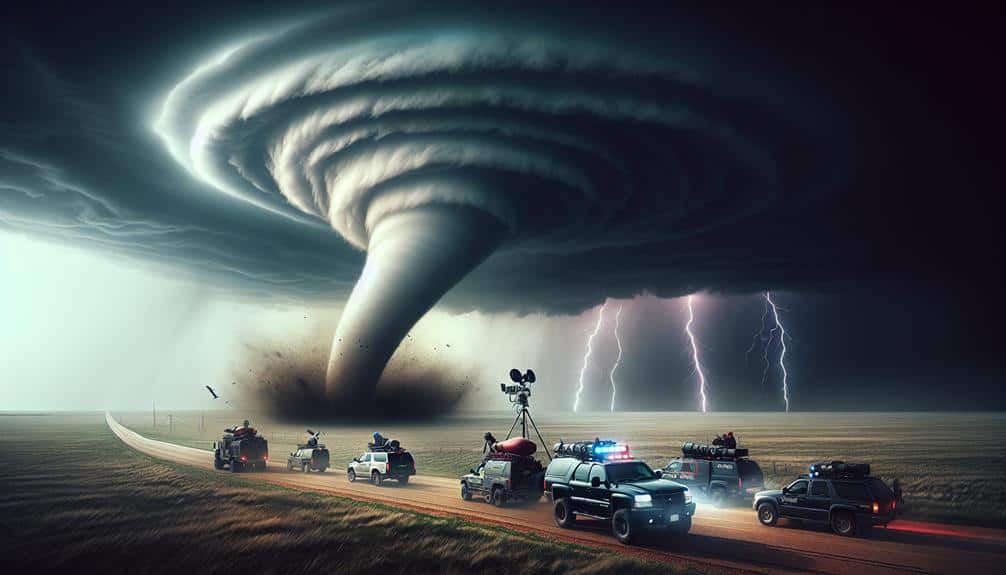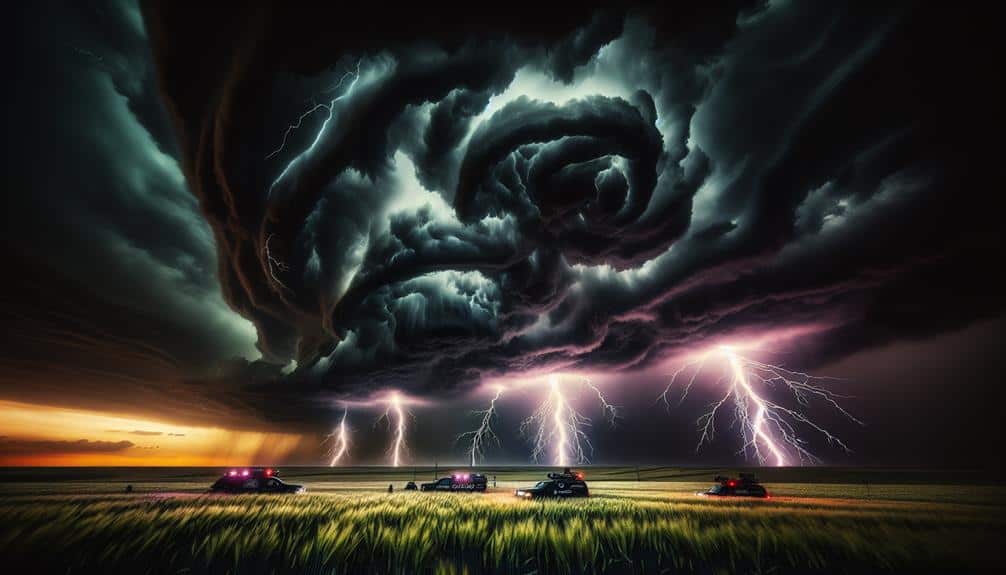In competing in storm chasing, we follow stringent rules and regulations to prioritize safety and data precision. Eligibility mandates participants be at least 21, with a minimum of 200 hours of storm chasing experience and a valid Storm Spotter Certification. Equipment standards include advanced GPS units, high-frequency radios, and vehicle-mounted anemometers. We rigorously enforce safety protocols like real-time weather monitoring and predetermined escape routes. Scoring is based on storm intensity, data accuracy, and footage quality. Unauthorized activities and safety violations result in severe penalties, including disqualification. Learn more about the exact regulations and protocols we observe.
Key Points
- Participants must be at least 21 years old with 200 hours of storm chasing experience and a valid Storm Spotter Certification.
- Teams need a meteorologist, driver, and data analyst, and must use advanced GPS, weather radar, and communication devices.
- Safety protocols require real-time weather monitoring, predetermined escape routes, and emergency medical kits.
- Scoring is based on storm intensity, data accuracy, footage quality, and real-time reporting efficiency.
Eligibility Criteria
To participate in storm chasing competitions, individuals must meet specific eligibility criteria including age, certification, and equipment standards. Age restrictions are non-negotiable; participants must be at least 21 years old. This guarantees maturity and the ability to handle high-stress situations.
Additionally, experience requirements mandate that individuals have logged a minimum of 200 hours of storm chasing to qualify. This data-driven approach guarantees that only seasoned chasers, who've encountered various storm types, participate.
Training certifications are also essential. All participants must hold a valid Storm Spotter Certification, typically obtained through programs like those offered by the National Weather Service (NWS). This certification validates our competency in storm identification and safety protocols. Moreover, advanced certifications in meteorology or related fields can enhance our credibility and competitive edge.
Team composition plays a crucial role, too. A standard team comprises a meteorologist, a driver, and a data analyst. Each member must meet the aforementioned experience and certification requirements. This multidisciplinary approach ensures we've the expertise to analyze storm data, navigate safely, and make real-time decisions.
Adhering to these eligibility criteria not only guarantees safety but also levels the playing field, allowing freedom for skilled chasers to compete effectively.
Equipment Standards
Adhering to strict equipment standards is essential in storm chasing, ensuring both safety and data accuracy. Our primary focus is on maintaining sturdy safety gear and reliable communication devices. High-quality helmets, reinforced gloves, and durable boots are non-negotiable. These items protect us from debris, extreme weather conditions, and potential injury.
We also utilize advanced GPS units and weather radar systems to provide real-time data, vital for making split-second decisions.
Communication remains a cornerstone of our operations. We deploy high-frequency radios and satellite phones, ensuring uninterrupted connectivity even in remote areas. These devices facilitate constant updates and coordination with team members and emergency services.
Additionally, we employ vehicle-mounted anemometers and barometers to measure wind speed and atmospheric pressure with precision.
Data acquisition is another vital component. We use high-resolution cameras and drones equipped with thermal imaging to capture thorough visual data. These tools allow us to analyze storm patterns and behavior meticulously. Specialized software processes this data, enhancing our predictive capabilities.
Safety Protocols
Implementing strict safety protocols is crucial in mitigating risks and promoting the well-being of our team during storm chasing operations. We've developed an all-encompassing set of guidelines designed to optimize safety while maximizing our operational freedom. These protocols include real-time weather monitoring, GPS tracking, and predetermined escape routes. Our team continuously analyzes meteorological data to adjust our position and avoid high-risk zones.
Emergency procedures are equally crucial. We maintain constant communication through multiple channels, including satellite phones and radio frequencies, ensuring all members can convey their status instantly. In the event of a vehicle breakdown or sudden storm intensification, our emergency procedures dictate immediate regrouping at designated safe zones. Each team member is trained in first aid and equipped with medical kits, ensuring prompt response to any injuries.
Moreover, our vehicles are fortified with reinforced glass and equipped with emergency supplies, such as water, non-perishable food, and thermal blankets. Regular safety drills ensure that everyone is familiar with evacuation protocols and emergency response actions.
Scoring System
Let's examine the intricacies of our scoring system.
We allocate points based on specific criteria such as storm intensity, captured data accuracy, and footage quality.
Additionally, time-based scoring and penalty deductions are integral components that affect overall rankings.
Points Allocation Criteria
In the context of competitive storm chasing, points are allocated based on a precise scoring system that quantifies various performance metrics, including storm intercepts, data collection accuracy, and real-time reporting efficiency. Our scoring system is meticulously designed to ensure scoring accuracy, rewarding teams for both quality and timeliness of their efforts.
Each storm intercept is graded on proximity to the storm core, duration of engagement, and the severity of the storm, with higher points awarded for more intense weather phenomena.
Data collection accuracy is another critical metric. Teams must provide precise meteorological data, such as barometric pressure, wind speed, and precipitation rates. The accuracy of this data is cross-referenced with official sources to ensure reliability. Points are deducted for any discrepancies, so teams must employ rigorous strategy planning to maximize their score.
Real-time reporting efficiency focuses on the promptness and clarity of updates provided during the chase. Points are awarded based on the speed of data transmission and the detail included in reports. Teams that can quickly and accurately communicate essential information to relevant authorities and the public earn higher scores, reflecting their operational effectiveness and contribution to public safety.
Time-Based Scoring
Incorporating time-based scoring allows us to quantitatively assess the timing precision of storm chasers' critical actions, emphasizing the significance of swift and accurate decision-making during high-stakes weather events. This scoring system hinges on the ability to execute speed challenges effectively, as participants must respond rapidly to dynamic atmospheric conditions.
Time-stamped data points, such as the exact moment a storm chaser captures footage of a tornado touchdown or initiates an emergency maneuver, are essential to our evaluation metrics.
We employ a tiered scoring system where each second saved translates into higher points. This methodology rewards those who not only act swiftly but also with strategic planning. For instance, reaching a safe observation point before a storm's peak intensity not only guarantees safety but also maximizes score potential.
Real-time GPS tracking and synchronized timestamps provide precise quantification of these actions, minimizing subjectivity.
Moreover, our scoring algorithm accounts for the complexity of maneuvers, assigning higher values to tasks completed under more challenging conditions. This nuanced approach guarantees that competitors are incentivized to balance speed with tactical acumen.
Ultimately, time-based scoring fosters an environment where freedom of movement and strategic agility are paramount.
Penalty Deductions Rules
While rewarding quick and strategic actions is crucial, we must also establish strict penalty deductions to safeguard fair play and safety compliance in storm chasing competitions.
Point deductions act as a deterrent against unsafe practices and rule violations, guaranteeing that all participants adhere to established guidelines.
Specifically, each violation incurs a predefined number of point deductions. For instance, failure to maintain a safe distance from the storm's core results in a 20-point deduction. Similarly, not following road safety regulations, such as speeding or running red lights, leads to a 15-point deduction. These penalty metrics are based on risk assessment data, emphasizing the seriousness of each infraction.
Violation consequences extend beyond mere point reductions; repeated offenses may lead to disqualification. For example, accumulating three major violations, such as unauthorized drone deployment within restricted airspace, triggers immediate disqualification. This multi-tiered approach secures that the scoring system remains fair and promotes responsible behavior.
Our goal is to balance the excitement of storm chasing with the necessity for stringent safety protocols. By implementing these penalty deductions, we create an environment where freedom thrives within the boundaries of safety and fairness. This structured approach not only enhances competition integrity but also safeguards the well-being of all participants.
Permitted Areas

Storm chasers must follow strict regulations that designate specific permitted areas for their activities. While these areas allow us to pursue our passion safely, they're carefully determined to balance both thrill and safety. Restricted zones are off-limits due to high risk or essential infrastructure, and enforcement of these areas is stringent. Violating these zones can result in severe penalties, including fines and disqualification from competitions.
Boundary lines for permitted areas are clearly demarcated on official maps, leaving little room for ambiguity. However, exceptions do exist, such as temporary access granted for scientific purposes or special events. Understanding these boundary lines and exceptions is essential for all participants.
Here are some key points to keep in mind:
- Permitted Areas: Always verify the latest maps and updates from regulatory authorities to make sure you're within the allowed zones.
- Restricted Zones: Familiarize yourself with restricted zones to avoid unintentional breaches and potential penalties.
Ethical Guidelines
Adhering to ethical guidelines safeguards our storm chasing activities prioritize safety, respect for property, and the integrity of scientific data collection. We must practice professional conduct at all times, securing our actions don't endanger lives or disrupt local communities. Our ethical responsibilities include obtaining proper permissions and avoiding restricted areas to respect private property and public lands.
Data integrity is paramount. We must collect and report data accurately to contribute valuable insights to meteorological research. Fabricating or manipulating data undermines the scientific community's trust and compromises future studies. Sharing our findings transparently with the broader community fosters collaboration and advances our understanding of severe weather.
Professional conduct extends to interactions with other storm chasers, emergency responders, and the public. We should offer assistance if we encounter individuals in distress and avoid obstructing emergency operations. Driving responsibly and complying with traffic laws prevent accidents and maintain our credibility.
Ethical responsibilities also encompass environmental stewardship. Minimizing our ecological footprint by avoiding unnecessary off-road driving and properly disposing of waste aligns with our commitment to preserving the natural landscape we study. By upholding these ethical guidelines, we guarantee storm chasing remains a respected and valuable scientific pursuit.
Penalties and Disqualifications

Let's address the critical area of penalties and disqualifications in storm chasing competitions.
We must enforce strict consequences for safety violations, leading to immediate disqualification for any misconduct.
Additionally, equipment non-compliance will incur specific penalties, ensuring all participants adhere to established standards.
Safety Violations Consequences
Safety violations in storm chasing competitions result in strict penalties and immediate disqualification, guaranteeing that all participants adhere to established protocols. We must emphasize the importance of personal responsibility and the consequences of failing to comply with safety measures. The enforcement of these rules is essential to maintain the integrity of the competition and safeguard all involved parties.
The penalties for safety violations are designed to be severe to deter non-compliance. This not only protects the participants but also secures that our events don't become chaotic or hazardous. The consequences of these violations can range from significant financial penalties to outright bans from future competitions. The following list outlines key repercussions:
- Financial penalties: Fines imposed to cover any damages or additional risks introduced.
- Points deduction: Loss of competition points, severely impacting standings and chances of winning.
Our enforcement of safety measures involves real-time monitoring and immediate action if violations are detected. This system guarantees that everyone can enjoy the freedom to chase storms within the boundaries of established, life-preserving protocols.
Misconduct Immediate Disqualification
In addition to the penalties for safety violations, misconduct such as tampering with equipment or falsifying data results in immediate disqualification from the competition. We firmly believe that maintaining the integrity of storm chasing is paramount. Any violation of data authenticity or equipment integrity undermines the credibility of our competitions and the scientific community. Immediate disciplinary action is non-negotiable.
We adhere to strict protocols to ensure fair play and respect for our peers. Sportsmanship violations, including unsportsmanlike conduct and unethical behavior, are taken seriously. For instance, if a participant is found to have interfered with another team's equipment or provided incorrect data to gain an unfair advantage, they're immediately disqualified. The severity of these violations mandates a zero-tolerance policy.
Data integrity is vital in storm chasing, where accurate information can mean the difference between success and failure. Our monitoring systems are designed to detect anomalies, ensuring transparency and fairness. In cases of confirmed misconduct, we don't hesitate to implement swift disciplinary action.
Equipment Non-compliance Penalties
Maintaining compliance with equipment standards is essential, and violations result in penalties or disqualifications to uphold the integrity of the competition. Our dedication to safety and fairness requires strict adherence to these standards. Equipment non-conformity can lead to significant safety violations, and the consequences are designed to be both corrective and preventive.
When we identify equipment non-conformity, we impose the following penalties:
- Immediate Suspension: Participants face immediate suspension from the competition until the discrepancy is rectified. This guarantees no further risk to safety or fairness.
- Point Deductions: Specific non-conformity issues result in point deductions from the team's overall score, directly impacting their competitive standing.
We implement these measures to not only maintain the competitive balance but also to guarantee that every participant operates under the same stringent safety protocols. Misconduct and disqualification aren't taken lightly, and our approach remains transparent and data-driven.
Frequently Asked Questions
How Do Storm Chasers Communicate With Each Other During a Chase?
A chain is only as strong as its weakest link; we use advanced communication methods like radio frequencies, mobile apps, and GPS to guarantee real-time coordination and safety protocols, maximizing our freedom to chase storms efficiently.
What Are the Typical Costs Involved in Storm Chasing Competitions?
We typically face equipment expenses and travel costs as major components. Funding sources like grants and sponsorship opportunities can offset these. Precision instruments, advanced radar, and fuel are significant, but necessary for accurate data and effective chasing.
How Does Weather Forecasting Play a Role in Storm Chasing?
We're not just weather geeks in a high-tech van; we're data-driven daredevils. Accurate weather forecasting dictates our equipment requirements and safety precautions, ensuring we maximize storm intercepts while minimizing risks. Freedom demands precision, folks.
Are There Any Famous Storm Chasing Events or Teams?
We often discuss famous events like the 2011 Super Outbreak in Tornado Alley. Top teams, such as Extreme Weather Squad, leverage cutting-edge technology to track data and chase storms, providing critical insights into these natural phenomena.
What Training Is Recommended for Aspiring Storm Chasers?
For aspiring storm chasers, mastering safety protocols and advanced navigation techniques is essential. We need rigorous meteorological training, storm spotting courses, and real-world experience to navigate extreme weather safely while embracing our freedom to chase nature's fury.


